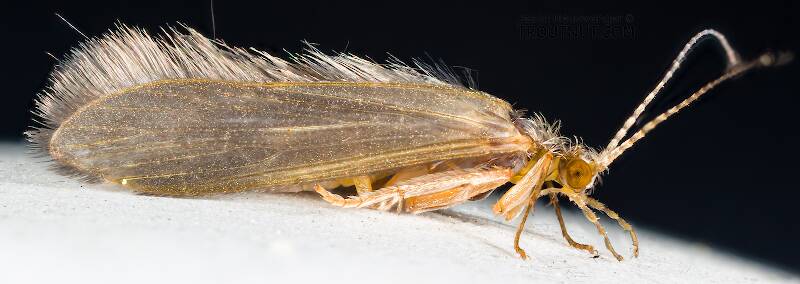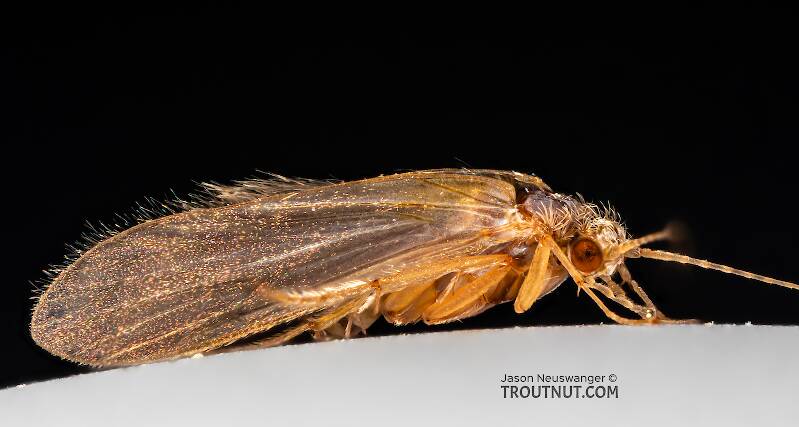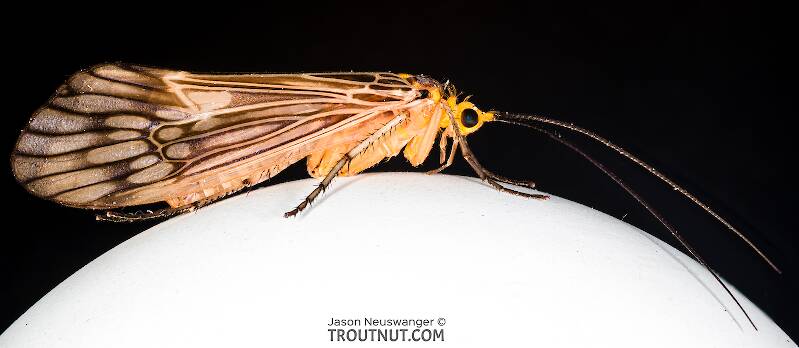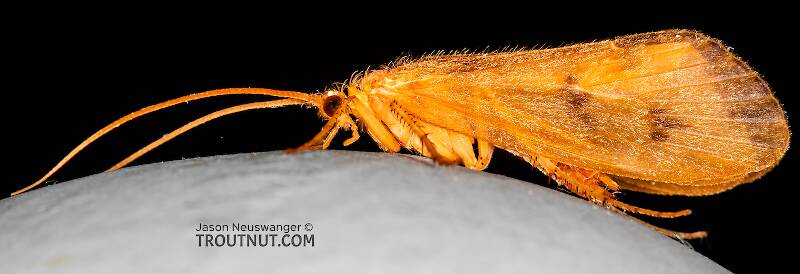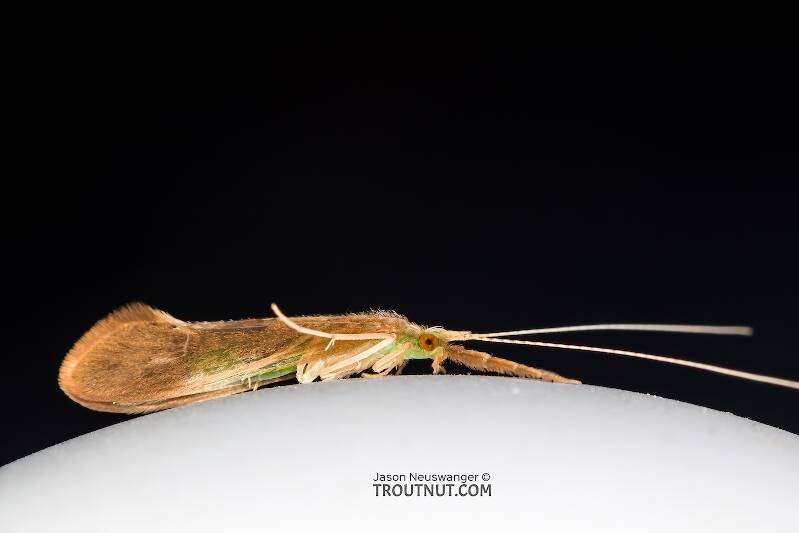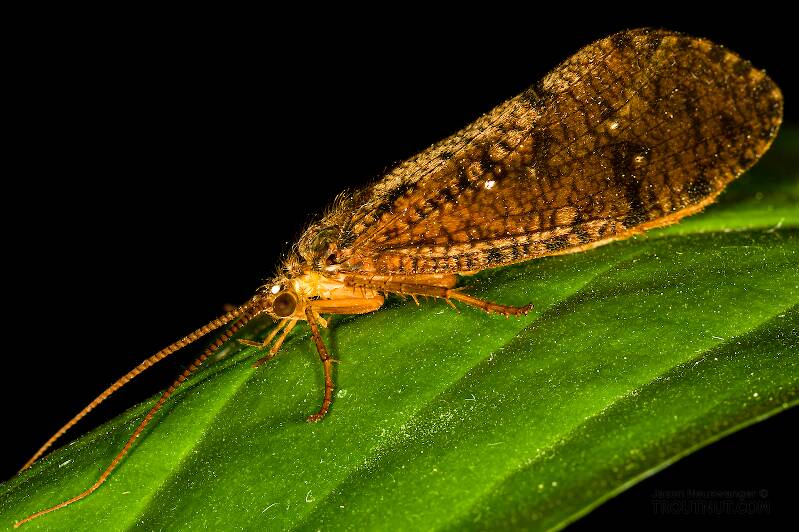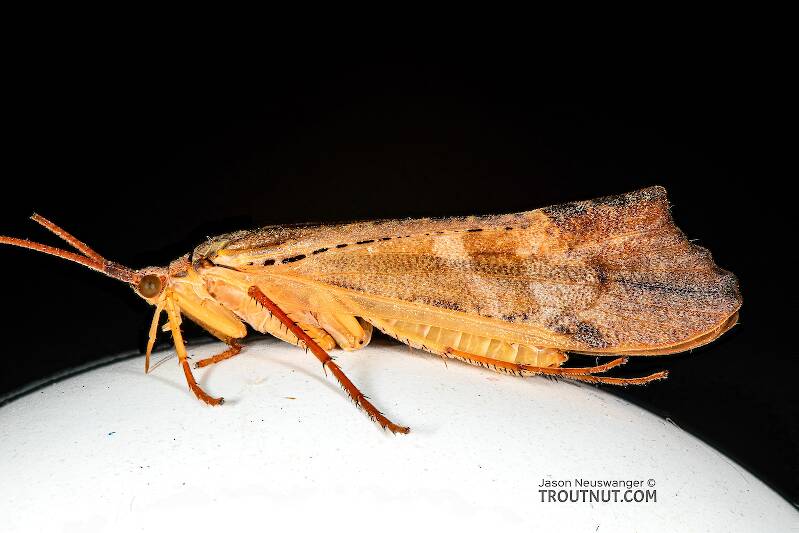
Blue-winged Olives
Baetis
Tiny Baetis mayflies are perhaps the most commonly encountered and imitated by anglers on all American trout streams due to their great abundance, widespread distribution, and trout-friendly emergence habits.
Featured on the forum

This seems to be a young larva of Limnephilus. Although not clear in the picture, several ventral abdominal segments have chloride epithelia.

Troutnut is a project started in 2003 by salmonid ecologist Jason "Troutnut" Neuswanger to help anglers and
fly tyers unabashedly embrace the entomological side of the sport. Learn more about Troutnut or
support the project for an enhanced experience here.
Identification: Key to Families of Caddisfly Adults
Identification: Key to Families of Caddisfly Adults
Error: Tried to access a key that isn't live.
Adapted from Merritt R.W., Cummins, K.W., and Berg, M.B. (2019)
This couplet refers figures (usually designated 'sf') from this source.
You will need the source (make sure to get the same edition!) to see them.
This couplet refers figures (usually designated 'sf') from this source.
You will need the source (make sure to get the same edition!) to see them.
| Option 1 | Option 2 |
|---|---|
| Body typically less than 5 mm long | Body length variable, often more than 5 mm |
| Mesoscutum without setose warts | Mesoscutum often with setal warts |
| Mesoscutellar warts transverse and meeting mesally to form angulate ridge (sf 19.562) | Mesoscutellar warts typically rounded or elongate (sf 19.55) |
| Hind wings narrow and apically acute, and often with a posterior fringe of long setae (sf 19.563) | Hind wings typically broader than at left and apically rounded (sf 19.589); if posterior fringe of setae present, then setae shorter than at left |
| Adults as in sf 10.194 | |
| Widespread | |
| Remaining families: Apataniidae, Beraeidae, Brachycentridae, Calamoceratidae, Dipseudopsidae, Ecnomidae, Glossosomatidae, Goeridae, Helicopsychidae, Hydrobiosidae, Hydropsychidae, Hydroptilidae, Lepidostomatidae, Leptoceridae, Limnephilidae, Molannidae, Odontoceridae, Philopotamidae, Phryganeidae, Polycentropodidae, Psychomyiidae, Rhyacophilidae, Rossianidae, Sericostomatidae, Thremmatidae, Uenoidae, and Xiphocentronidae | |
2 Example Specimens | 5 Example Specimens |
| Hydroptilidae | Go to Couplet 2 |
Adapted from Merritt R.W., Cummins, K.W., and Berg, M.B. (2019)
The current couplet is highlighted with darker colors and a icon, and couplets leading to this point have a icon.
Couplet 1 (You are here)
Leads to Hydroptilidae:
- Body typically less than 5 mm long
- Mesoscutum without setose warts
- Mesoscutellar warts transverse and meeting mesally to form angulate ridge (sf 19.562)
- Hind wings narrow and apically acute, and often with a posterior fringe of long setae (sf 19.563)
- Adults as in sf 10.194
- Widespread
Leads to Couplet 2:
- Body length variable, often more than 5 mm
- Mesoscutum often with setal warts
- Mesoscutellar warts typically rounded or elongate (sf 19.55)
- Hind wings typically broader than at left and apically rounded (sf 19.589); if posterior fringe of setae present, then setae shorter than at left
Couplet 2
Leads to Couplet 3:
- Head with 3 ocelli dorsally
Couplet 3
Leads to Couplet 14:
- Head without ocelli
Couplet 14
Leads to Philopotamidae:
- Maxillary palps each with 5 segments
- Terminal segment of maxillary palps flexible, curved, and of different structure from the preceding segments, typically at least twice as long as segment 4 (sf 19.564, 19.570)
Leads to Couplet 4:
- Maxillary palps each of 2, 3, 4, 5, or 6 segments
- Maxillary palp segment 5 or 6, if present, similar in structure to preceding segments and about the same length as segment 4 (sf 19.602, 19.603)
Couplet 4
Leads to Couplet 5:
- Maxillary palps each of 5 segments, segment 2 about as long as segment 1 and often rounded (sf 19.561)
Couplet 5
Leads to Couplet 8:
- Maxillary palps each of 2, 3, 4, 5, or 6 segments, segment 2 longer than segment 1 and slender (sf 19.602, 19.603)
Couplet 8
Leads to Couplet 6:
- Maxillary palps each with segment 2 rounded and globose (sf 19.561)
Couplet 6
Leads to Hydrobiosidae:
- Maxillary palps each with segment 2 not globose, but of same general shape as segment 2 (sf 19.558)
- Southwest distribution
Hydrobiosidae
Leads to Rhyacophilidae:
- Foretibiae each with preapical spur (sf 19.557)
- Adults as in sf 10.191
Leads to Couplet 7:
- Foretibiae without preapical spurs
Couplet 7
Leads to Glossosomatidae:
- Pronotum with mesal setal warts widely spaced (sf 19.559)
- Adults as in sf 10.196
Leads to Hydroptilidae:
- Pronotum with mesal setal warts closely approximated (as in sf 19.562)
- Northeast and northwest distribution
Leads to Phryganeidae:
- Middle tibiae each with 2 preapical spurs (sf 19.576), i.e. spurs typically 2, 4, 4 on the tibiae of the front, middle, and hind legs, respectively
Leads to Couplet 9:
- Middle tibiae each with 1 (sf 19.600) or no preapical spurs, i.e. spurs typically, 1, 2-3, 4 on the tibiae of the front, middle, and hind legs, respectively
Couplet 9
Leads to Couplet 10:
- Hind wings each with anterior margin bearing row of stout, apically hooked setae (sf 19.586)
Couplet 10
Leads to Couplet 12:
- Hind wings with anterior margins bearing only straight or slightly curved, normal setae, or none at all (sf 19.579)
Couplet 12
Leads to Couplet 11:
- Hind wings each with vein R1 complete, extending to apical margin of wing (sf 19.589)
Couplet 11
Leads to Thremmatidae:
- Forewings about 2.5 times as long as broad (sf 19.758, 19.759)
Leads to Couplet 13:
- Small black or dark gray insects
- Length of each forewing 3-8 mm
- Forewing without color pattern
Couplet 13
Leads to Limnephilidae:
- Medium or large insects
- Length of each forewing 12-35 mm
- Forewing with various colors and patterns
- Adults as in sf 10.199
Leads to Rossianidae:
- Hind wings each with fork I sessile or rooted, arising at or basal of one or more crossveins
- Hind wing fork II distal, arising well beyond any other forks or crossveins (sf 19.756)
- Northwest distribution
Rossianidae
Leads to Apataniidae:
- Hind wing each with fork I absent, or petiolate and arising beyond all crossveins
- Hind wing fork II more nearly basal, arising at level of other wing forks and crossveins (sf 19.604-19.608)
- Adults as in sf 10.19
- Appalachian Mountains, North, West
Leads to Couplet 15:
- Maxillary palps each with 5 or 6 segments
Couplet 15
Leads to Couplet 24:
- Maxillary palps each with fewer than 5 segments
Couplet 24
Leads to Couplet 16:
- Maxillary palps each with apparently 6 segments
Couplet 16
Leads to Couplet 17:
- Maxillary palps each with 5 segments
Couplet 17
Leads to Psychomyiidae
(Paduniella nearctica):
(Paduniella nearctica):
- Forewings about 4.5 mm long
- Founds in the Ozark Mountains in Arkansas and Missouri
Leads to Calamoceratidae
(Anisocentropus pyraloides):
(Anisocentropus pyraloides):
- Forewings 11-13 mm long
- Southeast distribution
Calamoceratidae
(Anisocentropus pyraloides)
(Anisocentropus pyraloides)
Leads to Couplet 18:
- Maxillary palps each with terminal segment 5 flexible, different in structure from preceding segments (with numerous transverse striae or annulations) and typically at least twice as long as penultimate segment
Couplet 18
Leads to Couplet 24:
- Maxillary palps each with terminal segment 5 similar in structure to preceding segments and typically about the same length as penultimate segment (sf 19.54), or palp with some segments bearing long setal brush (sf 19.597)
Couplet 24
Leads to Leptoceridae:
- Antennae much longer than body
- Middle tibiae without preapical spurs
Leads to Couplet 19:
- Antennae typically little, if any, longer than body
- If antennae longer than body, then middle tibiae with preapical spurs (sf 19.593)
Couplet 19
Leads to Couplet 20:
- Mesoscutum with setose warts (sf 19.565)
Couplet 20
Leads to Hydropsychidae:
- Mesoscutum without setose warts or setae (sf 19.572)
- Adults as in sf 10.192
Leads to Couplet 21:
- Mesoscutal setose warts ovoid, their combined area smaller than that of mesoscutellum (sf 19.565)
Couplet 21
Leads to Xiphocentronidae:
- Mesoscutal setose warts quadrate and appressed along median line, their combined area exceeding that of mesoscutellum (sf 19.574)
- Found in Arizona and Texas
Xiphocentronidae
Leads to Couplet 22:
- Foretibiae each typically with preapical spur (sf 19.567)
- If preapical spur absent, then basal segment of tarsus shorter than twice the length of the longer apical spur (as in sf 19.567)
Couplet 22
Leads to Psychomyiidae:
- Foretibiae without preapical spurs
- Basal segment of each tarsus at least twice the length of the longer apical spur (sf 19.569)
Leads to Ecnomidae:
- Forewings each with vein R1 branched near apex (sf 19.571)
- In the US, found only in Texas
Ecnomidae
Leads to Couplet 23:
- Forewings each with vein R1 unbranched (sf 19.573)
Couplet 23
Leads to Dipseudopsidae:
- Forewings each with vein R2 branched from R3 at radial crossvein (sf 19.573)
- Eastern distribution
Dipseudopsidae
Leads to Polycentropodidae:
- Forewings each with vein R2 and vein R3 either fused throughout as vein R2+3 (sf 19.568) or with the two veins separated near apex of wing (sf 19.566)
Leads to Beraeidae:
- Mesoscutum without setose warts and setae (sf 19.594)
- Tarsal segments 2-5 with spines only near their apices (sf 19.595)
- Eastern distribution (highly localized)
Beraeidae
Leads to Couplet 25:
- Mesoscutum with setose warts (sf 19.577, 19.578, 19.582, 19.596, 19.598) or setal areas (sf 19.590, 19.591)
- Tarsal segments 2-5 with spines typically arranged irregularly (sf 19.583)
Couplet 25
Leads to Couplet 26:
- Mesoscutal setae arising in diffuse area over nearly entire length of mesoscutum (sf 19.590, 19.591)
Couplet 26
Leads to Couplet 28:
- Mesoscutal setae largely confined to pair of small, discrete warts (sf 19.577, 19.578, 19.582, 19.596, 19.598)
Couplet 28
Leads to Calamoceratidae:
- Antennae with scapes twice as long as pedicels, head typically with posteromesal ridge dorsally (sf 19.590)
- East, Southeast, Southwest, West Coast
Calamoceratidae
Leads to Couplet 27:
- Antennae with scapes at least 3 times longer than pedicels
- Head without posteromesal ridge dorsally (sf 19.591)
Couplet 27
Leads to Leptoceridae:
- Antennae markedly longer than body
- Pronotum consisting of a pair of lateral erect, platelike warts separated by wide, mesal excavated collar usually hidden by produced, angulate anterior margin of mesonotum (sf 19.591)
- Middle tibiae without preapical spurs (sf 19.592)
Leads to Molannidae:
- Antennae little, if any, longer than body
- Pronotum with warts much closer together, not platelike
- Middle tibiae each with 2 preapical spurs (sf 19.593)
- Adults as in sf 10.198
Leads to Helicopsychidae:
- Head with posterior setose warts relatively large, extending from mesal margins of eyes ot mid-dorsal line and anteriorly to middle of head (sf 19.577)
- Antennae never longer than forewings
Leads to Couplet 29:
- Head with posterior setose warts smaller than at left (e.g. sf 19.596)
- If not as above, then antennae about 1.5 times as long as forewings
Couplet 29
Leads to Couplet 30:
- Mesoscutellum with single median setose wart extending over most or all of its length (sf 19.593)
Couplet 30
Leads to Couplet 31:
- Mesoscutellum with pair of setose warts occupying about half its length (sf 19.582) and sometimes touching along mid-dorsal line (sf 19.598)
Couplet 31
Leads to Odontoceridae:
- Mesoscutellum almost entirely covered by a single setose wart, with setae arising over most of the wart (sf 19.596), except bare mesally in Pseudogoera singularis
- Maxillary palps each 5-segmented, except 4-segmented in male Pseudogoera singularis
Leads to Sericostomatidae:
- Pronotal setose warts fused into single transverse wart on each side of mid-line
- Median fissure of mesoscutum deep (sf 19.579)
Sericostomatidae
Leads to Couplet 32:
- Pronotum with 2 discrete setose warts on each side of mid-line
- Median fissure of mesoscutum not deep as at left (sf 19.582)
Couplet 32
Leads to Brachycentridae:
- Middle tibiae each with 1 or 2 preapical spurs arising at point about one-third distance from apex of tibiae (sf 19.583), or middle tibiae without preapical spurs
- Abdominal segment 5 with internal glands opening in a pair of ventral sclerotized lobes (sf 19.584)
Leads to Lepidostomatidae:
- Middle tibiae each with 2 preapical spurs arising from about mid-point of tibia (sf 19.599)
- Ventral abdominal glands not apparent
- Adults as in sf 10.195
Start a Discussion of this Couplet
References
- Merritt R.W., Cummins, K.W., and Berg, M.B. 2019. An Introduction to the Aquatic Insects of North America (Fifth Edition). Kendall/Hunt Publishing Company.


